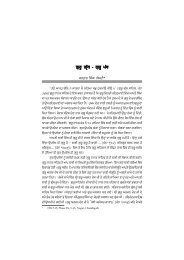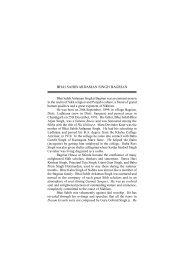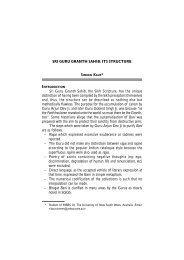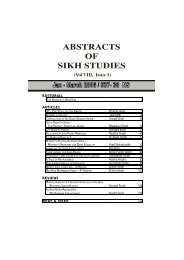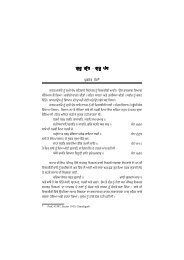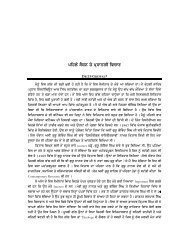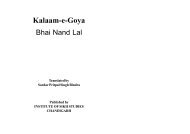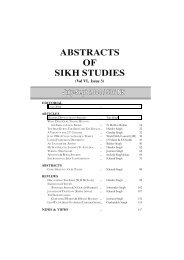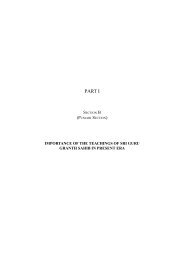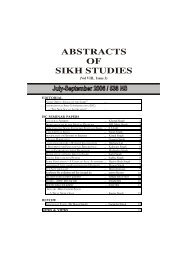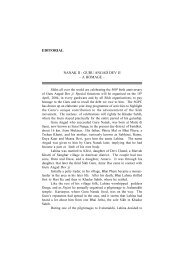editorial articles reviews news & views - Institute of Sikh Studies
editorial articles reviews news & views - Institute of Sikh Studies
editorial articles reviews news & views - Institute of Sikh Studies
Create successful ePaper yourself
Turn your PDF publications into a flip-book with our unique Google optimized e-Paper software.
114<br />
ABSTRACTS OF SIKH STUDIES : APRIL-JUNE 2005 / 537 NS<br />
to her notoriety. Her behaviour was typical <strong>of</strong> misl leader mentality,<br />
in order to compete for regional hegemony or to exact vengeance from<br />
a confederate.<br />
Author makes an erroneous claim that, “At the time <strong>of</strong> accession<br />
to the throne <strong>of</strong> his father, Ranjit Singh, was only 10 years old”. No<br />
kingdom had yet been established. At the time (1790) Lahore was<br />
under Bhangian misl rule. Sohan Singh Seetal, in his study <strong>of</strong> the misl<br />
period, writes, “Maharaja Ranjit Singh confiscated the entire territory<br />
<strong>of</strong> the (Naqaian) misl, in 1810, and bestowed these territories upon<br />
Prince Kharak Singh as a jagir”.<br />
The author makes a persuasive case about the fate <strong>of</strong> the Princes<br />
<strong>of</strong> the realm. He makes a good case for the murder <strong>of</strong> Prince Nau<br />
Nihal Singh; and punctures the myth <strong>of</strong> it being an accident. He<br />
provides a fairly compelling evidence suggesting that the young Prince<br />
Duleep Singh was brainwashed to embrace the Christian faith by his<br />
tutor Bhajun Lal, a Brahmin who had converted to Christianity, and<br />
his guardian, Dr John Spencer Login, a man imbued with missionary<br />
zeal.<br />
The author includes a homage paid by Qazi Nur Muhammad in<br />
his Jangnamah (1765), that draws a quintessential portrait <strong>of</strong> the <strong>Sikh</strong><br />
soldier as a noble warrior contrary to the scornfully inimical images<br />
(‘dogs’) promoted during Durrani’s jihad against the <strong>Sikh</strong>s.<br />
His narrative <strong>of</strong> the 1857 mutiny is enthralling. He discounts<br />
the notion <strong>of</strong> <strong>Sikh</strong> betrayal that resulted in its failure. Instead, he<br />
blames <strong>Sikh</strong> Rajahs and Poorbias, the duplicitous traitors who sided<br />
with the British.<br />
The book is the product <strong>of</strong> painstaking research. The author has<br />
sifted through a wide range <strong>of</strong> historical documents to build a case<br />
intended to modify our current thinking on some key turning points in<br />
<strong>Sikh</strong> history. His book will be a valuable addition in one’s collection.<br />
¤



